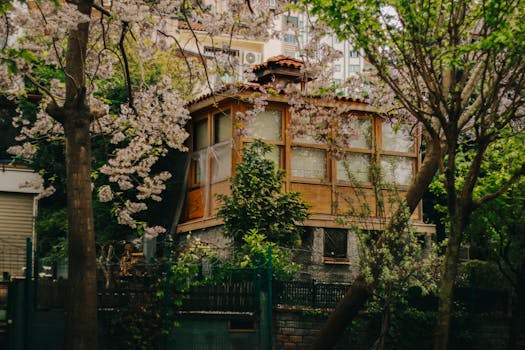
Urban Green Spaces: The Future of Outdoor Living in European Cities by 2025
Urban Green Spaces are becoming increasingly important in European cities, and for good reason. As the world becomes more urbanized, the need for green spaces has never been more pressing. By 2025, European cities are expected to have implemented innovative solutions to incorporate more green spaces into their urban planning, revolutionizing the way we live, work, and interact with our surroundings.
What are Urban Green Spaces?
Urban Green Spaces refer to areas in urban environments that are dedicated to natural habitats, parks, gardens, and other green areas. These spaces provide a range of benefits, including improved air quality, reduced noise pollution, and increased biodiversity. They also offer opportunities for recreation, socialization, and relaxation, making them an essential component of urban planning.
The Benefits of Urban Green Spaces
The benefits of urban green spaces are numerous and well-documented. Some of the most significant advantages include:
- Improved mental and physical health: Studies have shown that spending time in green spaces can reduce stress, improve mood, and even lower blood pressure.
- Increased property values: Homes and businesses located near green spaces tend to have higher property values, making them more desirable and valuable.
- Enhanced biodiversity: Urban green spaces provide habitats for a wide range of plant and animal species, helping to preserve biodiversity in urban areas.
- Climate regulation: Green spaces can help regulate the urban microclimate, reducing the urban heat island effect and mitigating the impacts of climate change.
European Cities Leading the Way
Several European cities are at the forefront of urban green space innovation, incorporating green roofs, vertical gardens, and other innovative solutions into their urban planning. Some notable examples include:
- Stockholm, Sweden: Known for its green roofs and walls, Stockholm is a leader in urban green space design.
- Copenhagen, Denmark: Copenhagen’s harbour area is being transformed into a green oasis, with plans for a new park and green space.
- Barcelona, Spain: Barcelona’s superblock program is reducing traffic and increasing green spaces, making the city more livable and sustainable.
Challenges and Opportunities
While urban green spaces offer many benefits, there are also challenges to be addressed. Some of the key obstacles include:
- Space constraints: Finding space for green areas in densely populated cities can be a significant challenge.
- Funding: Implementing and maintaining urban green spaces requires significant investment, which can be a barrier for some cities.
- Community engagement: Encouraging community involvement and engagement with urban green spaces is crucial for their success and longevity.
Conclusion
Urban Green Spaces are the future of outdoor living in European cities. By 2025, we can expect to see innovative solutions and initiatives that prioritize green spaces, transforming the way we live, work, and interact with our surroundings. As we move forward, it is essential to address the challenges and opportunities associated with urban green spaces, ensuring that these vital areas continue to thrive and benefit both people and the planet.
The Future of Urban Green Spaces
As we look to the future, it is clear that urban green spaces will play an increasingly important role in shaping the sustainability and livability of European cities. Some potential trends and developments to watch include:
- Increased use of green roofs and walls: As technology improves, we can expect to see more widespread adoption of green roofs and walls, providing additional green space in urban areas.
- Integration with smart city technologies: Urban green spaces may be integrated with smart city technologies, such as sensors and monitoring systems, to optimize their performance and benefits.
- Community-led initiatives: Community-led initiatives and participatory planning processes will become more prevalent, ensuring that urban green spaces reflect the needs and desires of local communities.
Case Studies
Several case studies demonstrate the effectiveness of urban green spaces in European cities. For example:
- The High Line in London: This elevated park built on an old rail line has become a popular destination for both locals and tourists, showcasing the potential for urban green spaces to revitalize neglected areas.
- The Park Avenue in Oslo: This green space in the heart of Oslo provides a peaceful oasis for residents and visitors, demonstrating the importance of urban green spaces in promoting mental and physical well-being.
Policy and Planning
Effective policy and planning are crucial for the successful implementation and maintenance of urban green spaces. Some key considerations include:
- Urban planning policies: Cities should prioritize green spaces in their urban planning policies, ensuring that new developments incorporate adequate green areas.
- Funding and investment: Governments and private investors should provide funding and investment for urban green space initiatives, recognizing the long-term benefits and returns on investment.
- Community engagement: Cities should engage with local communities to ensure that urban green spaces reflect their needs and desires, promoting a sense of ownership and responsibility.
Conclusion
Urban Green Spaces are a vital component of sustainable and livable European cities. By prioritizing green spaces, cities can improve the health and well-being of their residents, support biodiversity, and contribute to a more sustainable future. As we look to 2025 and beyond, it is essential to continue innovating and investing in urban green spaces, ensuring that these vital areas continue to thrive and benefit both people and the planet.
Focus Keyword: Urban Green Spaces. The future of outdoor living in European cities is closely tied to the development and implementation of urban green spaces. By 2025, we can expect to see significant advancements in this area, transforming the way we live, work, and interact with our surroundings.
Recommendations
Based on the findings and trends outlined in this article, several recommendations can be made for the future development of urban green spaces in European cities:
- Prioritize community engagement and participation in the planning and design of urban green spaces.
- Invest in innovative solutions and technologies, such as green roofs and walls, to maximize the potential of urban green spaces.
- Develop and implement effective policies and planning strategies to ensure the long-term sustainability and maintenance of urban green spaces.
Final Thoughts
Urban Green Spaces are the future of outdoor living in European cities. By 2025, we can expect to see significant advancements in this area, transforming the way we live, work, and interact with our surroundings. As we move forward, it is essential to prioritize community engagement, innovative solutions, and effective policy and planning, ensuring that these vital areas continue to thrive and benefit both people and the planet.






